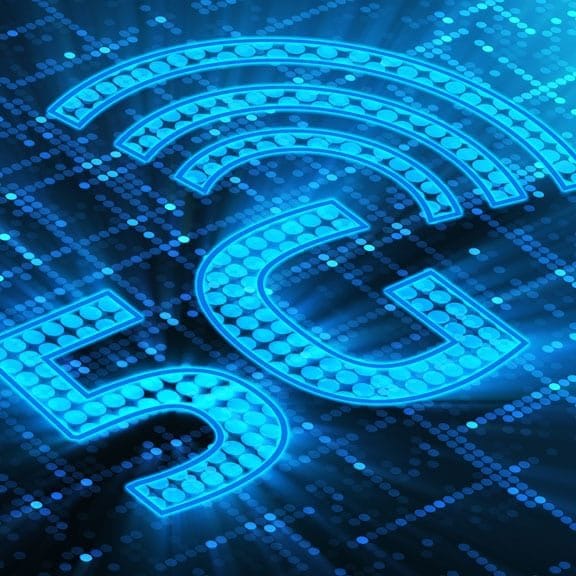5G and IoT: Use Cases and Applications for Emerging Technology
By Marco Contento
October 6, 2022
By Marco Contento
October 6, 2022
As society enters the information age’s next phase, recent advancements have given rise to faster wireless data exchange, including:
4G tops out at speeds around 2 Gbps. 5G technology pushes mobile performance from 2.4 Gbps (LTE Category 20) to reach nearly 20 Gbps by the arrival of 5G-Advanced (3GPP Release 18). Thus, 5G adds a viable high-speed data networking alternative to wired fiber optic networks.
Internet of Things (IoT) solutions will connect more than 30 billion devices by 2025. While 5G rolls out at neck-breaking speed, the resulting evolution in communications will bring the world a faster, smarter future.
Read on to discover how businesses are utilizing and preparing for 5G mobile IoT today. Learn how this innovative technology will improve every facet of our working and personal lives.

5G is the current cellular communication system generation. As an evolutionary standard, it is being rolled out in phases.
With IoT-enabled devices in mind, 5G connects a higher density of devices at higher speeds and makes things lag nearly non-existent. As a result, 5G creates an excellent user experience irrespective of what application, device or service you touch.
Massive cellular IoT technologies are characterized as low-cost, low-power consumption solutions. They thrive on deep and broad coverage indoors and outdoors. Massive cellular IoT delivers:
5G’s adaptability enables businesses and industrial organizations to connect more devices with better capability for less.
As proposed by GSMA, mobile IoT refers to cellular low-power wide-area (LPWA) technologies using licensed spectrum bands. 3GPP narrowband IoT (NB-IoT) and Long-Term Evolution machine-type communication (LTE-M) technologies are 5G-era bearers of low-power, low-data IoT applications. Cellular LPWA paves the path to 5G with undisrupted information flow. These 4G technologies continue under full support in 5G networks for many years and releases.
3GPP technologies like 4G LTE and 5G help businesses expand the reach of their IT and OT networks across hard-to-reach areas. They require an easily scalable deployment strategy and architecture.
Think of smart utility solutions in water and gas grids. Managers must remotely monitor environmental conditions from thousands of sensors and control valves and regulators to support consumer usage.
In addition, they must prevent or mitigate line breaks and other failure conditions across multiple sites. Managers must react in milliseconds to avert disaster and loss of life. IoT enables all the tools and resources managers need.
Cellular networks are adapting to the need to service billions of new devices. These devices require connectivity solutions that make the grade in business dimensions and technically.
Enterprises deploying either NB-IoT or LTE-M are future-proofing their IoT projects. As 5G becomes commonplace, these mobile IoT standards continue to integrate into upcoming 5G releases, as seen in 3GPP Release (Rel) 16 and Rel 17.
Early 5G IoT use cases focused on:
As adoption grows, they will evolve and use public and private networks to stream virtual and augmented reality and 3D video (which requires high bandwidth). Moreover, 5G applications will be used for critical communications like factory automation, uncrewed aerial vehicles (UAVs) and more.
5G IoT will improve everyday life from personal applications to changing how we work and live.
With 5G IoT, facilities will continue improving to send critical upgrades to networks without freezing functionality or overloading servers.
Current industries that will continue benefiting from these 5G IoT enhancements include:

Smart homes, synced watch-and-phone IoT devices and fitness apps are commonplace. They will grow with the speed and performance capabilities of 5G. With a heavy reliance on mobile IoT on such a grand scale today, in the next 20 years, the 5G future will look completely different.
We will see large-scale autonomous vehicle deployments and utility service automations like waste management. We will also see energy production through smart grids and smart environmental monitoring to reduce greenhouse gases and pollution.
Imagine being able to park a smart car in a parking garage and gaining wireless charging through the city grid while you work. Then you can message your vehicle to drive from the parking garage to your office door.
Farmers will be able to monitor and track crops, livestock and machinery through drones and super-dense sensor networks.
Home users will be able to fully integrate the COVID-led work-from-home paradigm, which looks likely to survive the pandemic as a new corporate norm. In addition, home users will be capable of optimizing power usage and streaming their favorite entertainment from anywhere.
Society will be more efficient, smart cities will live up to their name, and users can expect personalized streams of information catered to their liking.
As a worldwide leader in IoT solutions, we simplify your enterprise’s evolution and enable you to make the most of 5G.
Speak with our IoT experts to find a cellular LPWA module and a custom IoT data plan and formulate a deployment strategy.
Request to qualify for a 5G sample kit and catch up to the future today.
Editor’s Note: This blog was originally published on 13 February 2019 and has since been updated.